|
| ART IN CANADA
|
 |
|
Visual art is a large part of Canadian culture, and spans the centuries from before the Europeans set foot in North America, to the berth of successful Canadian artists working today.
ABORIGINAL ART
Aboriginal people resided on this land for countless generations before the country was officially claimed and established as Canada. They were responsible for hand carved and painted totem poles and masks, as well as dance and music. Artistic mediums and methods varied greatly depending where in the country each group was located, and the materials they had at their disposal.
When European settlers began to arrive, their "Western" practices and objects were adopted and blended into traditional Aboriginal art, including glass beads and metal. Much of the older Aboriginal artwork shown in museums and galleries today is indicative of these periods of interaction between cultures.
EUROPEAN ART
Naturally, European immigrants brought their own traditional art practices with them when they settled in Canada. Some areas were settled by groups who did not believe in ostentatious ornamentation, and as a result they did not progress as quickly as other areas.
In 1870, the Canadian Society of Artists was formed, made up of Ontario and Quebec artists from varying cultural and artistic backgrounds. The popular styles, so chosen primarily because they sold well, were Romanticism and Realism.
CANADIAN ART
At the turn of the 19th century, some artists began exploring the concept of a distinctly Canadian style, though their influence stemmed from the Art Nouveau style popular in the design community, where they met. Known officially as the Group of Seven following their first formal exhibit in 1920, their landscape paintings remain the most widely recognized Canadian art.
Today, artistic centres such as Vancouver, British Columbia, and Toronto, Ontario, as well as many other cities across the country, offer a wealth of education and career options to Canadian artists. Despite some established "Canadian" styles, many artists still use the influence of their ancestral heritage, resulting in a collection of national work which makes Canadian art particularly difficult to define as anything but "eclectic".
|
ART GALLERIES AND MUSEUMS
- The Art Gallery of Ontario, commonly known as the AGO, was established more than century ago in 1900. Located in the Downtown Grande Park district of Toronto, the gallery has a collection of more than 80,000 pieces that showcase artistic movements and media from the first century to today. In addition to the largest collection of Canadian art, the gallery is also home to many Renaissance and Baroque artworks, as well as Oceanic, African and European.
Within the permanent collection reside works by Tom Thompson, Emily Carr, and the Group of Seven. There are also paintings by Picasso, Matisse, Dali, Rothko, and O'Keeffe.
In addition to the exhibition galleries, the AGO boasts a formal restaurant, cafe, library and student spaces, artist-in-residence, research centre, lecture hall,
and gift shop. The latter was designed by world-renowned architect Frank Gehry.
- One of the best known art galleries in Canada, the Montreal Museum of Fine Arts (Musée des beaux-arts de Montreal) occupies four pavilions with 140,000 square feet of exhibition space. The oldest library in the country dedicated to the study of art also makes its home on the grounds. The museum was established in 1860.
The permanent collection housed within the museum includes a number of Inuit artworks, as well as pieces by Tom Thompson, and James Wilson Morrice. Non-Canadian pieces are also in residence, such as Renaissance medallions, pieces inspired by Caravaggio, Dutch and Flemish Baroque paintings, works by Nicholas Poussin and Rembrandt, Courbet and Renoir.
The MMFA was the site of the largest and most infamous art theft in Canadian history. In 1972, a group of armed robbers made off with jewelry, sculptures, and eighteen paintings (including a Rembrandt), the total of which is estimated to be worth over $11 million today. The items have never been recovered.
- The National Gallery of Canada is located in Ottawa, Ontario with a view of the parliament buildings, and is one of the best known art galleries in the country. Established in 1880, the gallery is home to over 150,000 artworks, including 125,000 contemporary photographic images. As well as the exhibition galleries, the building houses a garden courtyard and a reconstructed 19th-century chapel.
Though much of the permanent collection focuses on Canadian art, the National Gallery also possesses many works of American and European art, including artists such as Andy Warhol, Francis Bacon, Paul Cezanne, Gustav Klimt, Piet Mondrian, and Auguste Rodin. Canadian artists include Louis-Philippe Hébert, Tom Thompson, Emily Carr, and Alex Colville. Indiginous Canadian artists include Frederick Alexcee, Charlie Sivuarapik, Iyola Kingwatsiak, and David Neel.
- Founded in 1912, the Winnipeg Art Gallery in Manitoba is the 6th largest art gallery in Canada. With a collection of nearly 24,000 artworks, the WAG focuses on regional and national artists, though they also have a selection of Greek sculpture dating back to the 4th century BCE. The world's largest public collection of Inuit art makes its home within the walls, as well as photography and decorative arts.
True to the gallery's mission, the building in which it currently resides was built by a local architect in 1971. Over the years additional vault space and a new roof sculpture garden have been added to the institution. In addition to Inuit artists Marion Tuu'luq, Kiashuk, Joseph Pootoogook, and Jesse Oonark, the permanent collection includes pieces by Canadian artists John Hammond, Robert Harris, and William Brymner, and international artists Marie Laurencin, Augustus John, Henry Moore, and Eugene-Louis Boudin.
- The Art Gallery of Alberta (formerly the Edmonton Art Gallery) is located in Edmonton, Alberta, and hosts many visiting exhibitions and educational programs in addition to holding a permanent collection of more than 6,000 artworks. Established in 1924, the Brutalist building in which it had resided since the late 1960s was renovated recently to an 85,000 square foot location with twice as much display space, a restaurant, gift shot, theatre, and a dedicated exhibition space for the collection.
Within the gallery's small but notable collection are works by A.Y. Jackson, George Reid, David Milne, Emily Carr, and Frederick Verner. Other draws include many talks and lectures, film screenings, and family activities.
Other Art Galleries and Museums in Canada:
- MacKenzie Art Gallery, Regina, Saskatchewan
- Art Gallery of Nova Scotia, Halifax
- Five Island Art Gallery, Tors Cove, Newfoundland
- Confederation Centre Art Gallery, Charlottetown, Prince Edward Island
- Museum of Contemporary Canadian Art, Toronto, Ontario
- Open Sky Creative Society, Fort Simpson, NWT
- Beaverbrook Art Gallery, Fredericton, New Brunswick
- Art Gallery of Greater Victoria, Victoria, British Columbia
- Banff Centre, Banff, Alberta
- Actual Gallery, Winnipeg, Manitoba
- Vancouver Art Gallery, Vancouver, British Columbia
- A Space Gallery, Toronto, Ontario
- Art Mûr, Montreal, Quebec
- Dunlop Art Gallery, Regina, Saskatchewan
- Copper Moon Gallery, Whitehorse, Yukon
- Art Beatus, Vancouver, British Columbia
|
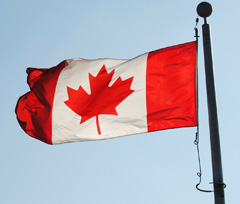
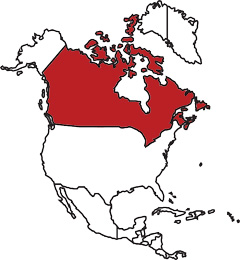
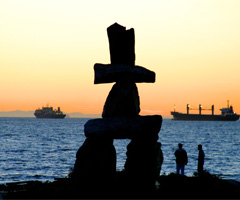
A stone inukshuk near English Bay, Vancouver, B.C
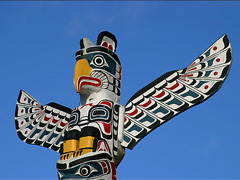
Native American Totems
|
ARTISTIC INSTITUTIONS
- The Emily Carr University of Art and Design opened in 1925 as the Vancouver School of Decorative and Applied Arts, and originally served just 90 students in Vancouver, British Columbia. Many well known Canadian and European artists taught at the school, including Group of Seven member Fred Varley. The school's first graduating class consisted of nine women and two men, and the onset of the Depression encouraged artistically inclined young people to pursue the design courses offered.
In 1978, the school was officially renamed the Emily Carr College of Art. By the time it attained University status in 2008, the facility was a sought after destination for those seeking a career in the arts. Students can achieve a Bachelor of Design, Fine Art, or Media Art, with concentrations in film, photography, ceramics, drawing, interaction design, animation, and many more. Graduate programs are also offered in the areas of digital media, design, and applied arts.
- Established in 1887 as the Victoria School of Art and Design, the Nova Scotia College of Art and Design, better known as NSCAD, offers Bachelor of Fine Art, Design, and Art History, as well as Master's programs in fine art and design. The school is located in Halifax, Nova Scotia.
In addition to the many educational programs offered at the Granville Street campus, the school is also home to a collection of historic art and ceramics, contemporary art, and prints, which are showcased in the Anna Leonowens Gallery. A second gallery exhibits the work of students, faculty, and visiting artists.
- The Yukon School of Visual Arts offers high school graduates a foundation year program that prepares them for a degree in Fine Arts or Design. Once students have completed the program, they can continue their studies at one of the various Canadian art schools with which SOVA is affiliated, including the two schools outlined above.
Established in 2007, SOVA exposes new students to interactions with other established and prospective artists, and offers courses in humanities and studio art. Those who do not wish to continue on to another university are left with the necessary building blocks for a career in the arts.
- A campus of Fleming College in Haliburton, Ontario, Haliburton School of the Arts offers certificate programs in a wide variety of unique concentrations, including Artist Blacksmith, Expressive Arts, Fibre Arts, Glass Blowing, and Museum Management. They also offer a post graduate course in Studio Process Advancement. Students take part in fifteen-week intensive certificate programs that are the equivalent of one year of study.
In addition to their yearly programs, the school also offers summer art courses - more than 300 of them between May and August - available to students of any skill level. The campus is also home to the Haliburton Sculpture Forest, which features works of three dimensional art by both Canadian and International artists.
Other Art Schools and Classes in Canada
- MacEwan University, Edmonton, Alberta
- Fanshawe College, London, Ontario
- New Brunswick College of Craft & Design, Fredericton, New Brunswick
- School of the Arts, McMaster University, Hamilton, Ontario
- Toronto School of Art, Ontario
- Victoria College of Art and Design, British Columbia
- Alberta College of Art and Design, Calgary, Alberta
|
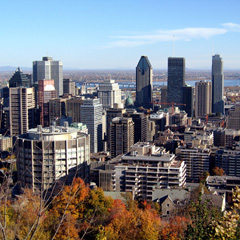
Montreal, Quebec
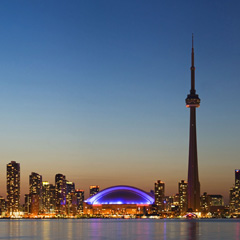
Toronto, Ontario
|
NATIVE ARTISTS
In addition to the well known Group of Seven landscape painters of the early 20th century, there are plenty of artists who made their name in Canada over the years:
- Known as the Picasso of the North, Norval Morrisseau (1931-2007) was an Aboriginal Canadian artist whose artworks depicted the legends of the Anishinaabe people, as well as the cultural tensions between native and European tradition.
- William Brymner (1855-1925) was an art instructor and figure and landscape painter. Though he was born in Scotland, he spent most of his life in Canada and taught many members the Beaver Hall Group, a Montreal-based art collective.
- A postmodern painter and sculptor, as well as a successful writer, Douglas Coupland has many public artworks displayed in Vancouver, British Columbia, and Ottawa and Toronto, Ontario.
- Landon Mackenzie is a Vancouver-born painter and art professor who is known for her large-format artworks. Her paintings have been exhibited at major galleries across the country.
- Ontario-born artist Benjamin Chee Chee (1944-1977) is recognized for his simplified paintings and line drawings that use minimal color and smooth shapes to depict birds and animals.
- Actors Ryan Gosling, Michael J. Fox, Christopher Plummer, Leslie Nielson, and Ryan Reynolds.
|
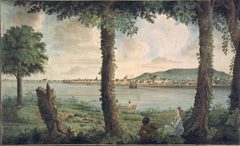
A View of Montreal in Canada, Thomas Davies, 1762
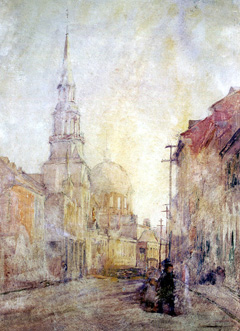
Bonsecours Church and Market, William Brymner, 1913
|
ART AND CULTURAL EVENTS
Annual Events
- The Harmony Arts Festival in Vancouver, British Columbia began in 1990. Showcasing visual art, music, and culinary delights together in "harmony", the festival draws nearly 150,000 visitors over its 10-day run. In addition to the Art Market, where tents of artists selling their wares line the streets, the event also hosts art workshops and three exhibits. The festival begins at the end of July.
- Since 1985, The Works art and design festival in Edmonton, Alberta features one square kilometre of art displays and entertainment that is free to the public. Running over twelve days, the event offers interactive activities, art exhibits, stage performances, discussions, and various receptions and parties celebrating individual facets of the festival.
- Art Toronto has been held each October since the start of the 21st century. Over four days, the event showcases the work of modern and contemporary artists, and combines this visual display with lectures and panel discussions by significant art personalities from around the world.
- Each year in June, the MURAL Festival showcases urban art that is free of charge to the public. Its inaugural event in 2013 brought more than 800,000 visitors out to view graffiti paintings, sculpture, installation, and public dance, music, and film screenings.
- Halifax's Nocturne art event is held each October, and brings visitors to the city's downtown after nightfall to view the best of the local visual arts scene, free of charge. Light installations line the streets, galleries stay open late, and a map directs guests through the participating spaces around the neighbourhood.
Other Events and Sights to See
- The Manitoba Art Expo, in October.
- Banff National Park, outside Calgary, Alberta
- The CN Tower, in Toronto, Ontario
- Stanley Park in Vancouver, British Columbia
- The Calgary Stampede, each July in Alberta
- The Toronto Zoo, in Ontario
- The Manitoba Museum, in Winnipeg
- Temple Gardens Mineral Spa, Moose Jaw, Saskatchewan
- The Citadel of Quebec, Quebec City
- Peggy's Cove, Nova Scotia
- Niagara Falls, in Ontario
|
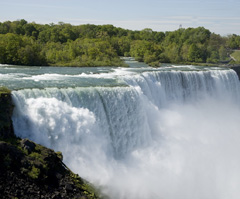
Niagara Falls
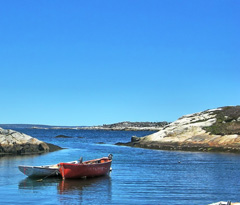
Peggy's Cove
|
|
© 2002-2025 - KeenART Media Ltd.
|
|
| |
|

